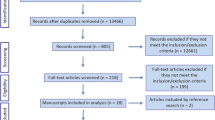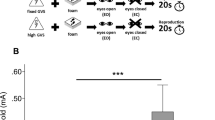Abstract
The goal of this study is to assess how reflexes and intrinsic properties contribute to low-back stabilization and modulate with conditions. Upper body sway was evoked by anterior–posterior platform translations, while subjects were seated with a restrained pelvis and free upper body. Kinematic analysis of trunk translations and rotations illustrated that a fixed rotation point between the vertebrae L4 and L5 adequately captures lumbar bending up to 5 Hz. To investigate the motor control modulation, the conditions varied in vision (eyes open or closed), task instruction (Balance naturally or Resist perturbations by minimizing low-back motions), and perturbation bandwidth (from 0.2 up to 1, 3 or 10 Hz). Frequency response functions and physiological modeling parameters showed substantial modulation between all conditions. The eyes-open condition led to trunk-in-space behavior with additional long-latency visual feedback and decreased proprioceptive feedback. The task instruction to resist led to trunk-on-pelvis stabilization behavior, which was achieved by higher co-contraction levels and increased reflexive velocity feedback. Perturbations below the low-back natural frequency (~1 Hz) led to trunk-on-pelvis stabilization behavior, mainly attributed to increased intrinsic damping. This indicates that bandwidth effects should not be ignored and that experiments with high-bandwidth perturbations do not fully represent the intrinsic and reflexive behavior during most (low-bandwidth) daily life activities. The neck stabilized the head orientation effectively (head rotation amplitudes 2 % of trunk), but did not effectively stabilize the head in space (global head translations exceeded trunk translations by 20 %). This indicates that low-back motor control is involved in head-in-space stabilization and could explain the low-back motor control modulations due to vision.








Similar content being viewed by others
Abbreviations
- LBP:
-
Low-back pain
- FRF:
-
Frequency response functions
- RMS:
-
Root mean square
- γ 2(f):
-
Coherence
- VAF:
-
Variance accounted for
- SEM:
-
Standard error of the mean
- BT:
-
Task instruction to balance naturally
- B1:
-
Perturbation signal with bandwidth of 0.2–1 Hz
- B3:
-
Perturbation signal with bandwidth of 0.2–3 Hz
- B10:
-
Perturbation signal with bandwidth of 0.2–10 Hz
- EC:
-
Eyes-closed conditions
- EO:
-
Eyes-open conditions
- RT:
-
Task instruction to resist the perturbation by minimizing flexion/extension excursions
- P(t):
-
Perturbation signal
- X GT(t):
-
Global torso translations
- X RT(t):
-
Relative torso translations
- θ T(t):
-
Torso rotations
- X GH(t):
-
Global head translations
- X RH(t):
-
Relative head translations
- θ H(t):
-
Head rotations
- E(t):
-
EMG signal
- X(f):
-
FRF of translations
- θ(f):
-
FRF of rotations
- E(f):
-
FRF of EMG
- θ mdl(t):
-
Estimated model rotations
- E mdl(t):
-
Estimated model EMG
- m :
-
Mass (model)
- h :
-
Pendulum height (model)
- b :
-
Intrinsic damping (model)
- k :
-
Intrinsic stiffness (model)
- k v :
-
Reflexive velocity feedback gain (model)
- k p :
-
Reflexive position feedback gain (model)
- τ ref :
-
Reflexive time delay (model)
- f act :
-
Muscle activation cutoff frequency (model)
- d act :
-
Muscle activation damping factor (model)
- e scale :
-
EMG scaling parameter (model)
- k vis :
-
Visual position feedback gain (model)
- τ vis :
-
Visual time delay (model)
References
Berthoz A, Lacour M, Soechting J, Vidal P (1978) The role of vision in the control of posture during linear motion. Prog Brain Res 50:197–209
Bobet J, Norman RW (1990) Least-squares identification of the dynamic relation between the electromyogram and joint moment. J Biomech 23:1275–1276. doi:10.1016/0021-9290(90)90386-h
Brown SHM, McGill SM (2008) Co-activation alters the linear versus non-linear impression of the EMG–torque relationship of trunk muscles. J Biomech 41:491–497. doi:10.1016/j.jbiomech.2007.10.015
Brown SHM, McGill SM (2009) The intrinsic stiffness of the in vivo lumbar spine in response to quick releases: implications for reflexive requirements. J Electromyogr Kinesiol 19:727–736. doi:10.1016/j.jelekin.2008.04.009
Buchanan JJ, Horak FB (1999) Emergence of postural patterns as a function of vision and translation frequency. J Neurophysiol 81:2325–2339
Cholewicki J, Polzhofer GK, Radebold A (2000) Postural control of trunk during unstable sitting. J Biomech 33:1733–1737
Clauser CE, McConville JT, Young JW (1969) Weight, volume, and center of mass of segments of the human body. Aerospace Medical Research Laboratory. Wright-Patterson Air Force Base, Ohio
Collins JJ, De Luca CJ (1995) The effects of visual input on open-loop and closed-loop postural control mechanisms. Exp Brain Res 103:151–163. doi:10.1007/BF00241972
Day BL, Séverac Cauquil A, Bartolomei L, Pastor MA, Lyon IN (1997) Human body-segment tilts induced by galvanic stimulation: a vestibularly driven balance protection mechanism. J Physiol 500:661–672
Forbes P, Bruijn E, Schouten A, Helm FT, Happee R (2013) Dependency of human neck reflex responses on the bandwidth of pseudorandom anterior-posterior torso perturbations. Exp Brain Res 226:1–14. doi:10.1007/s00221-012-3388-x
Gardner-Morse MG, Stokes IAF (2001) Trunk stiffness increases with steady-state effort. J Biomech 34:457–463. doi:10.1016/s0021-9290(00)00226-8
Goodworth AD, Peterka RJ (2009) Contribution of sensorimotor integration to spinal stabilization in humans. J Neurophysiol 102:496–512. doi:10.1152/jn.00118.2009
Goodworth AD, Peterka RJ (2010) Influence of bilateral vestibular loss on spinal stabilization in humans. J Neurophysiol 103:1978–1987. doi:10.1152/jn.01064.2009
Granata KP, Rogers E (2007) Torso flexion modulates stiffness and reflex response. J Electromyogr Kinesiol 17:384–392
Guitton D, Kearney RE, Wereley N, Peterson BW (1986) Visual, vestibular and voluntary contributions to human head stabilization. Exp Brain Res 64:59–69. doi:10.1007/bf00238201
Halliday DM, Rosenberg JR, Amjad AM, Breeze P, Conway BA, Farmer SF (1995) A framework for the analysis of mixed time series/point process data—Theory and application to the study of physiological tremor, single motor unit discharges and electromyograms. Prog Biophys Mol Biol 64:237–278. doi:10.1016/s0079-6107(96)00009-0
Jenkins GM, Watts DG (1969) Spectral analysis and its applications. Holden-Day, San Francisco
Kiemel T, Elahi AJ, Jeka JJ (2008) Identification of the plant for upright stance in humans: multiple movement patterns from a single neural strategy. J Neurophysiol 100:3394–3406. doi:10.1152/jn.01272.2007
Ljung L (1999) System identification: theory for the user, 2nd edn. PTR Prentice Hall, Upper Saddle River
Loney PL, Stratford PW (1999) The prevalence of low back pain in adults: a methodological review of the literature. Phys Ther 79:384–396
Loram ID, Lakie M (2002) Direct measurement of human ankle stiffness during quiet standing: the intrinsic mechanical stiffness is insufficient for stability. J Physiol 545:1041–1053. doi:10.1113/jphysiol.2002.025049
Moorhouse KM, Granata KP (2007) Role of reflex dynamics in spinal stability: intrinsic muscle stiffness alone is insufficient for stability. J Biomech 40:1058–1065. doi:10.1016/j.jbiomech.2006.04.018
Mugge W, Abbink DA, van der Helm (2007) FCT Reduced power method: How to evoke low-bandwidth behaviour while estimating full-bandwidth dynamics. In: The IEEE 10th international conference on rehabilitation robotics (ICORR), Noordwijk aan Zee (The Netherlands), pp 575–581
Picavet HSJ, Schouten JSAG (2003) Musculoskeletal pain in the Netherlands: prevalences, consequences and risk groups, the DMC3-study. Pain 102:167–178. doi:10.1016/s0304-3959(02)00372-x
Pintelon R, Schoukens J (2001) System identification: a frequency domain approach. Wiley, New York
Radebold A, Cholewicki J, Polzhofer GK, Greene HS (2001) Impaired postural control of the lumbar spine is associated with delayed muscle response times in patients with chronic idiopathic low back pain. Spine 26:724–730
Staudenmann D, Potvin JR, Kingma I, Stegeman DF, van Dieën JH (2007) Effects of EMG processing on biomechanical models of muscle joint systems: sensitivity of trunk muscle moments, spinal forces, and stability. J Biomech 40:900–909. doi:10.1016/j.jbiomech.2006.03.021
Stein RB, Kearney RE (1995) Nonlinear behavior of muscle reflexes at the human ankle joint. J Neurophysiol 73(1):65–72
van der Helm FCT, Schouten AC, de Vlugt E, Brouwn GG (2002) Identification of intrinsic and reflexive components of human arm dynamics during postural control. J Neurosci Methods 119:1–14. doi:10.1016/s0165-0270(02)00147-4
van der Kooij H, Donker S, de Vrijer M, van der Helm F (2004) Identification of human balance control in standing. In: Systems, man and cybernetics, 2004 IEEE international conference on, 10–13 Oct. 2004. vol 2533, pp 2535–2541
van der Kooij H, van Asseldonk E, van der Helm FCT (2005) Comparison of different methods to identify and quantify balance control. J Neurosci Methods 145:175–203. doi:10.1016/j.jneumeth.2005.01.003
van Dieën JH, Selen LPJ, Cholewicki J (2003) Trunk muscle activation in low-back pain patients, an analysis of the literature. J Electromyogr Kinesiol 13:333–351
van Drunen P, Maaswinkel E, van der Helm FCT, van Dieën JH, Happee R (2013) Identifying intrinsic and reflexive contributions to low-back stabilization. J Biomech 46:1440–1446. doi:10.1016/j.jbiomech.2013.03.007
Veldpaus FE, Woltring HJ, Dortmans LJMG (1988) A least-squares algorithm for the equiform transformation from spatial marker co-ordinates. J Biomechan 21:45–54. doi:10.1016/0021-9290(88)90190-X
Willigenburg N, Kingma I, van Dieën J (2010) How is precision regulated in maintaining trunk posture? Exp Brain Res 203:39–49
Acknowledgments
This research is supported by the Dutch Technology Foundation STW, which is part of the Netherlands Organization for Scientific Research (NWO), and which is partly funded by the Ministry of Economic Affairs. See www.neurosipe.nl—Project 10732: QDISC.
Author information
Authors and Affiliations
Corresponding author
Appendix
Appendix
See Table 2 and Figs. 9, 10 and 11.
FRFs of the head kinematics and EMG during the 10-Hz perturbations and the eyes-closed condition. The head kinematics are described by the global translations in space (X GH), the translations relative to the pelvis (X RH) and rotations in space (θ H). The gain (amplitude difference), phase (time shift) and coherence (correlation) illustrate the transformation of the input signal into the output signal. The different colors represent the natural balance (blue) and the resist (red) task. The triangles are given as reference to the slope of the gains indicating stiffness (+2), damping (+1) and mass (0) in the relative translations and rotations and position feedback (0), velocity feedback (+1) and acceleration, and/or force feedback (+2) in the EMG. This is Fig. 4 but for head kinematics
Kinematics and EMG modulation due to task instruction (balance and resist), bandwidth (B1, B3 and B10), and vision (eyes closed (solid) and open (striped)). Gains and phases were averaged over the low frequencies (<1 Hz). Values are the mean and standard deviations over subjects. A lower X GH-gain and a larger phase lag for X RH and θ H describes modulation toward head-in-space stabilization. Modulation toward head-on-pelvis is illustrated by a X GH closer to 1 (gain) and 0° (phase) and smaller gains for X RH and θ H. This is Fig. 5 but for head kinematics
Rights and permissions
About this article
Cite this article
van Drunen, P., Koumans, Y., van der Helm, F.C.T. et al. Modulation of intrinsic and reflexive contributions to low-back stabilization due to vision, task instruction, and perturbation bandwidth. Exp Brain Res 233, 735–749 (2015). https://doi.org/10.1007/s00221-014-4151-2
Received:
Accepted:
Published:
Issue Date:
DOI: https://doi.org/10.1007/s00221-014-4151-2







